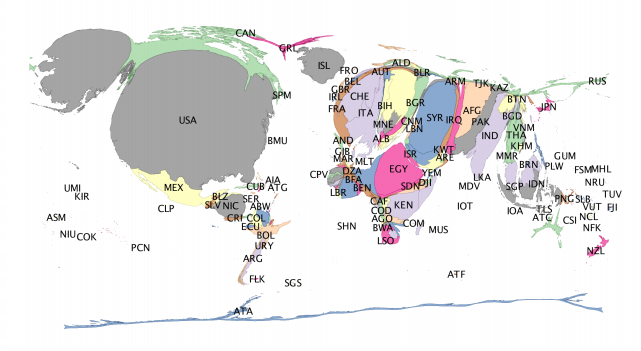Data Mining Reveals How News Coverage Varies Around the World
One interesting question about the nature of news is how well it reflects the pattern of real events around the world. It’s natural to assume that people living in a certain part of the world are more likely to read, see and hear about news from their own region. But what of the international news they get—how does that compare to the international news that people in other parts of the world receive?

Today, we get an answer to these questions thanks to the work Haewoon Kwak and Jisun An at the Qatar Computing Research Institute in Qatar. These guys have analyzed the news agendas in different parts of the world to see how the coverage reflects actual events in other parts of the world. And to visualize the different news agendas, they’ve created cartograms to reflect the coverage. These are maps in which the land area of a country is distorted by the amount of news coverage it receives in a given region (the image above shows how international news is viewed in North America).
Kwak and An begin with a database of 195,000 disasters that occurred between April 2013 and July 2014 and which were reported by more than 10,000 news outlets around the world. They noted the country in which each news outlet was based and then counted the published stories from other parts of the world. Finally, for various regions, they created a map of the world showing where the news was from.
The maps make for interesting viewing. They clearly show how the news agenda differs across the planet. Unsurprisingly, people in south Asia consume far more news about disasters in that region than people in North America, for example. And people in Latin America consume far more news from Argentina than Europe.
More interesting are the anomalies. For example, people everywhere consumed relatively large amounts of news from Egypt and Syria, mainly about the unrest in these countries and the accompanying humanitarian crises.
Kwak and An go on to investigate the factors that determine why people in one part of the world view disaster news from another. They found, for example, that population size is significant. People in all regions are more likely to see disaster news from other large countries, probably because there are more likely to be immigrants from those large countries who provide demand for that kind of coverage.
But by far the biggest factor that determines news coverage is whether an international news agency, such as Reuters, or Associated Press, covers the disaster. That’s unsurprising given that most news outlets have subscriptions to one or more agencies and are therefore able to use their stories easily. This is the primary mechanism behind the way news stories sometime snowball around the world.
Interesting work that reveals the way patterns of news coverage change around the globe.
Ref: http://arxiv.org/abs/1410.3710: Understanding News Geography and Major Determinants of Global News Coverage of Disasters
Keep Reading
Most Popular
Large language models can do jaw-dropping things. But nobody knows exactly why.
And that's a problem. Figuring it out is one of the biggest scientific puzzles of our time and a crucial step towards controlling more powerful future models.
How scientists traced a mysterious covid case back to six toilets
When wastewater surveillance turns into a hunt for a single infected individual, the ethics get tricky.
The problem with plug-in hybrids? Their drivers.
Plug-in hybrids are often sold as a transition to EVs, but new data from Europe shows we’re still underestimating the emissions they produce.
Stay connected
Get the latest updates from
MIT Technology Review
Discover special offers, top stories, upcoming events, and more.